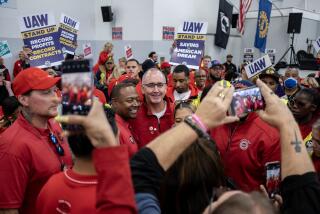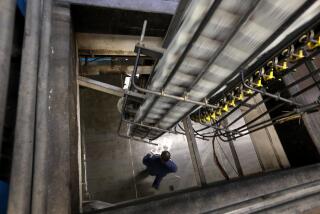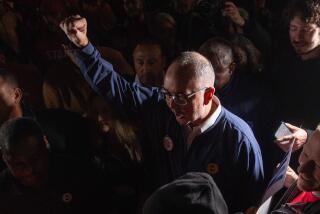Japan Comes to Kentucky : Toyota Gears Up to Open U.S. Factory in May
- Share via
TOYOTA CITY, Japan — David Everly, a 37-year-old visitor from Elizabethtown, Ky., struggled to keep pace with the half-built Toyota Camrys inching relentlessly down the assembly line, one every 58 seconds.
All around him, more experienced Japanese workers welded and buffed with seemingly inexhaustible deftness. Everly, his solid 6-foot frame a liability as he ducked and pivoted on a line scaled to smaller bodies, worked up a good sweat and fell further and further behind.
“They work really hard here,” Everly had said earlier with admiration. “My main job will be to motivate American workers to work as hard and as fast as Japanese workers. Frankly, I think it’s going to be a challenge.”
Plenty at Stake
Everly, who will be a “team leader” when Toyota opens its first North American factory in May in Georgetown, Ky., thinks he can do it. Toyota, Japan’s biggest car maker and a relative latecomer in opening its own U.S. plant, hopes he’s right.
At stake is a $1.1-billion investment Toyota expects to make in Georgetown, where a car factory and newly built access road named “Cherry Blossom Way” have risen from the horse-training fields of rural northern Kentucky. Also at stake, in a sense, is the changing economic relationship between the United States and Japan, which is moving from exporter to direct investor in American land, industry and labor.
To increase the chances of success, Toyota has been bringing its newly hired American workers, most of whom have never built an automobile, to its corporate center here for monthlong training courses. The meticulously planned, $55-million education program, paid for mostly by the taxpayers of Kentucky and the United States, aims at nothing short of exporting the Toyota spirit--the group loyalty, dedication to the company and willingness to work hard--that has helped make Toyota such a success.
The process has not been easy for either side. American workers have had to contend with bowing, raw eggs for breakfast and total withdrawal from Kentucky basketball.
Pleased With Training
The Japanese trainers, plucked from the line to begin learning English months ago, have been tutored in AIDS, the no-smoking movement and the peculiarities of American etiquette: shaking hands, looking people in the eye and not slurping spaghetti. They have learned not to be too solicitous toward women workers, a group that does not exist on the assembly lines of Toyota’s Japanese plants.
With about 230 future foremen trained so far--”group leaders” and “team leaders” in Toyotaspeak--both sides say they are pleased with the results.
“They are more dexterous than I expected, and easier to teach,” said Nobuyuki Matsuoka, Everly’s trainer, as he watched his protege at work. On a table next to the assembly line lay a mimeographed sheet of Japanese phrases with English translations, beginning with “My name is . . . “ and emphasizing, “Let’s do our best!”
“If these trainees implement the Toyota production system step by step,” Matsuoka added, “I believe it can be successfully exported to Kentucky.”
Toyota, of course, is not the first. Honda already exports Ohio-made cars to Japan, Nissan operates a plant in Tennessee and Toyota builds cars in Fremont, Calif., in a joint venture with General Motors.
But Toyota hesitated long before building its own plant, and then planned its training program with characteristic thoroughness. Now Toyota executives are hoping to achieve Japanese-level quality and productivity in their U.S. plant.
“Ten years ago, I was not confident that Toyota could be successful in the United States, where many top-class producers existed,” said Kaneyoshi Kusunoki, a director of Toyota Motor Corp. and president of the Kentucky venture. “The importance of the Japanese economy in the world has shifted over the past 10 years.”
And, Kusunoki added in a recent interview, “I really have great faith in the people in Kentucky.”
Disciplined Drill
The feeling appears to be mutual. More than 93,000 people have applied for 2,000 jobs. One-third of those hired so far have college degrees.
On a recent Friday, the day began with breakfast at 6 a.m. for Walt Klein, 28, and for about 50 other American workers in the third week of their Japanese tour.
Klein, broad and bearded, is a big man, even by Kentucky standards. Big enough to give his trainer, the compact Tomohiko Ushijima, pause.
“When I saw him, I thought he was very, very big,” Ushijima, 44 and a Toyota employee for 18 years, acknowledged. “I was worried whether he could work in such a small space. But, as you can see, he can move very quickly. I didn’t have to worry.”
By 7:45 a.m., Klein was sitting with Ushijima and a dozen other workers in the bumper meeting room. Although they would not start getting paid until 8, the entire bumper assembly team was in uniform, ready to work, discussing the day ahead.
With inspirational messages and warm-up exercises finished, the workers were in position before the starting bell sounded.
For two hours, the bumper assembly team and the rest of the factory workers toiled without rest, some of them literally running from task to task. Even when the siren sounded for a 10-minute coffee break, many workers continued working for a minute or two while others gathered into small groups for further cheerleading sessions on safety and hard work.
In the eyes of some workers, there is a price to be paid for such discipline. Ronald Dore, a British sociologist, once wrote that “joining Toyota as a regular worker is indeed rather more like joining the Army in America than like going to work for General Motors.
“You can expect to get ‘posted’ from one plant to another and even have to uproot the family as a consequence,” Dore wrote. “You can expect to have your leave canceled in an emergency.”
Nor, if you object to such treatment, can you expect much help from the company union, which sees its role mostly as a partner of the corporation dedicated to increasing productivity for the good of all.
So far, the American workers seem willing to buy into that philosophy. But Kusunoki, the Toyota executive in charge of the U.S. plant, said he has no illusions about the difficulty of transplanting the spirit of “mutual trust” into American employees.
“We are successful in the first step,” he said. “I can say that they all have the basic understanding of the spirit, and they all basically agree to the spirit.
“But once they start working at the plant, they may face some problems, and they may raise some questions about the spirit,” Kusunoki said.
Different Perceptions
For example, he said, Toyota operates on the principle of kaizen-- constant improvement. But U.S. workers may think, at first, that if they suggest ways to speed production, their wages should rise accordingly.
Moreover, Kusunoki said, some U.S. workers will question Toyota’s expectation that strong workers will work harder, when necessary, to carry slower or weaker workers in their team.
“Americans tend to have a clear-cut sense of individual responsibility, but when it comes to teamwork and helping each other, I see some differences between Americans and Japanese,” he said.
Eventually, Kusunoki said, he expects the Japan-trained American workers, in concert with Japanese trainers who will be sent to Kentucky, to overcome these crises of doubt.
Toyota is betting that the American workers it trains will stay long enough to repay its investment. Although most of the direct costs for the training program are borne by Kentucky state, and federal subsidies offered as incentives for Toyota’s investment, Toyota is bearing some of the costs, too. And, in the long run, the success of its $1.1-billion investment depends on the training program.
The Americans in Toyota City said they have made a long-term commitment, too.
There was a time, Everly said, when Americans fed up with their jobs would quit and go find other work. “You can’t do that anymore,” he said.” This is my last job.”






